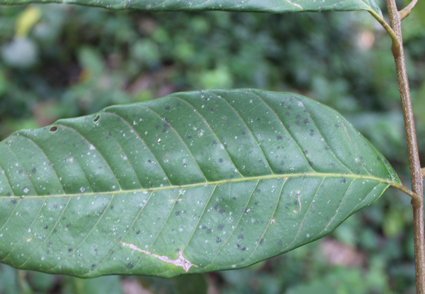Abstract
A new species of black mildew causing fungus infecting Aglaia perviridis (Meliaceae) collected from Southern Western Ghats of Kerala State, India is described and illustrated. Simple straight setae with variously dentate apex and opposite antrorse appressoria having apex of head cells attenuated are the features which distinguish the species from other Meliola biotrophs associated on the host family Meliaceae. This is the third species of Meliola reported infecting the host genus Aglaia from Western Ghats of India.
References
Hansford, C.G. (1937) Contributions towards the fungus flora of Uganda– I. The Meliolineae of Uganda. Botanical Journal of the Linnean Society 51: 265–284.
Hansford, C.G. (1961) The Meliolineae. Sydowia Annales Mycologici, Ser. II, Beihefte 2: 400–420.
Hongsanan, S., Tian, Q., Peršoh, D., Zeng, X.Y., Hyde, K.D., Chomnunti, P., Boonmee, S., Bahkali, A.H. & Wen, T.C. (2015) Meliolales. Fungal Diversity 74 (1): 91–141. https://doi.org/10.1007/s13225-015-0344-7
Hosagoudar, V.B. (1996) Meliolales of India. Botanical Survey of India, Calcutta, pp. 351–366.
Hosagoudar, V.B. (2008) Meliolales of India. Vol. II. Botanical Survey of India, Calcutta, pp. 155–354.
Hosagoudar, V.B. (2013) Meliolales of India. Vol. III. Journal of Threatened Taxa 5 (6): 3993–4068. https://doi.org/10.11609/jott.o3307.3993-4068
Hosagoudar, V.B. & Kapoor, J.N. (1985) New technique of mounting meliolaceous fungi. Indian Phytopathology 38: 548–549.
Hosagoudar, V.B., Mathew, S.P. & Babu, D. (2014) Foliicolous fungi of Andaman Islands, India. Journal of Threatened Taxa 6 (2): 5447–5463. https://doi.org/10.11609/jott.o3652.5447-63
Hosagoudar, V.B. & Sabeena, A. (2014) Foliicolous fungi of Wayanad District in Kerala State, India. Journal of Threatened Taxa 6 (7): 5909–6052. https://doi.org/10.11609/jott.o3658.5909-6052
Jayawardena, R.S., Hyde, K.D., Chen, Y.J., Papp, V., Palla, B., Papp, D., Bhunjun, C.S., Hurdeal, V.G.,Senwanna, C., Manawasinghe, I.S., Harischandra, D.L., Gautam, A.K., Avasthi, S., Chuankid, B., Goonasekara, I.D., Hongsanan, S., Zeng, X.Y., Liyanage, K.K., Liu, N., Karunarathna, A., Hapuarachchi, K.K., Luangharn, T., Raspé, O., Brahmanage, R., Doilom, M., Lee, H.B., Mei, L., Jeewon, R., Huanraluek, N.,Chaiwan, N., Stadler, M. & Wang, Y. (2020) One stop shop IV: taxonomic update with molecular phylogeny for important phytopathogenic genera: 76–100 (2020). Fungal Diversity 103: 87–218. https://doi.org/10.1007/s13225-020-00460-8
Niranjan, M. & Sarma, V.V. (2018) A check-list of fungi from Andaman and Nicobar Islands, India. Phytotaxa 347 (2): 101–126. https://doi.org/10.11646/phytotaxa.347.2.1
Pinho, D.B., Firmino, A.L., Ferreira-Junior, W.G. & Pereira, O.L. (2013) New Meliolaceae from the Brazilian Atlantic Forest 2: species on host families Annonaceae, Cecropiaceae, Meliaceae, Piperaceae, Rubiaceae, Rutaceae and Tiliaceae. Mycologia 105 (3): 697–711. https://doi.org/10.3852/12-163
Sabeena, A., Biju, H., Thomas, J., Biju, C.K. & Mathew, S.P. (2017) Three new Foliicolous Ascomycetes from Andaman Islands, India. Bio Bulletin 3 (1): 74–79.
Zeng, X.Y., Zhao, J.J., Hongsanan, S., Chomnunti, P., Boonmee, S. & Wen, T.C. (2017) A checklist for identifying Meliolales species. Mycosphere 8 (1): 218–359. https://doi.org/10.5943/mycosphere/8/1/16


